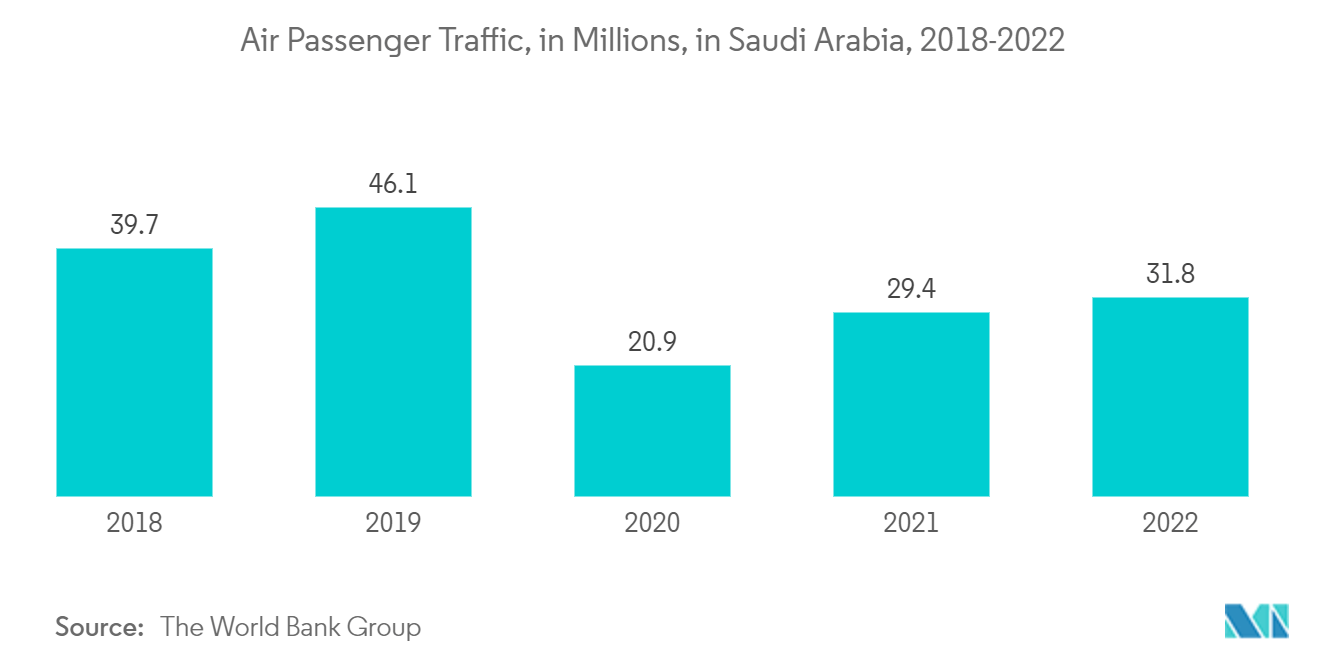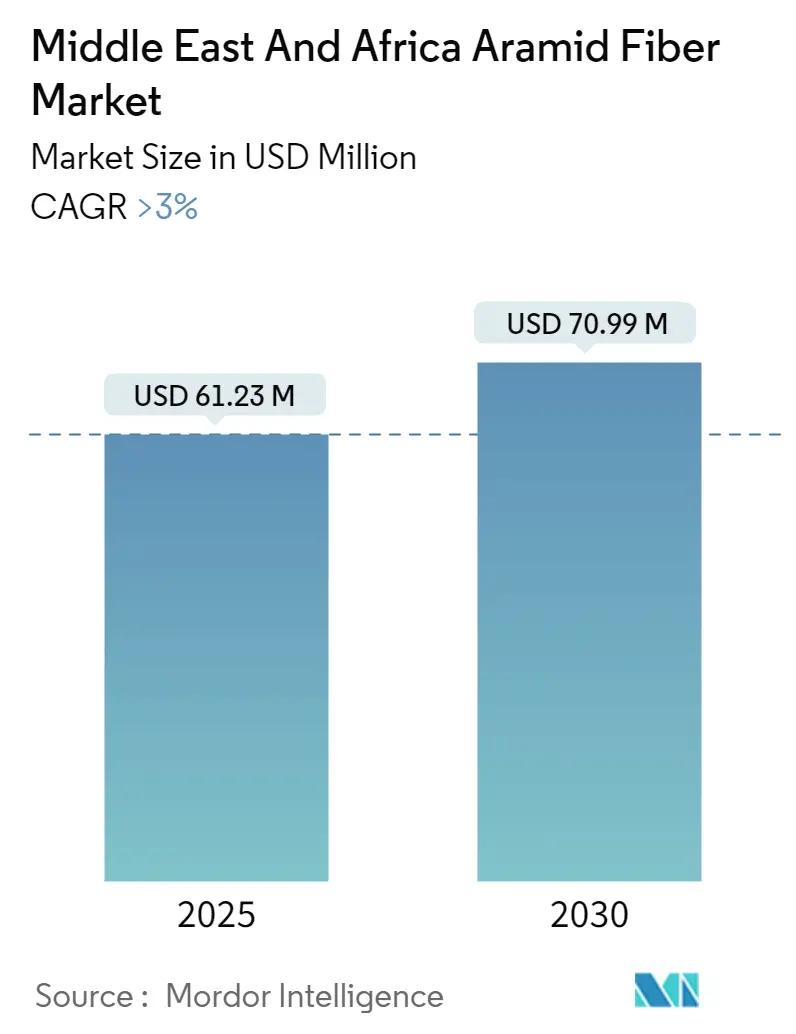
| Study Period | 2019 - 2030 |
| Base Year For Estimation | 2024 |
| Forecast Data Period | 2025 - 2030 |
| Market Size (2025) | USD 61.23 Million |
| Market Size (2030) | USD 70.99 Million |
| CAGR (2025 - 2030) | 3.00 % |
| Market Concentration | High |
Major Players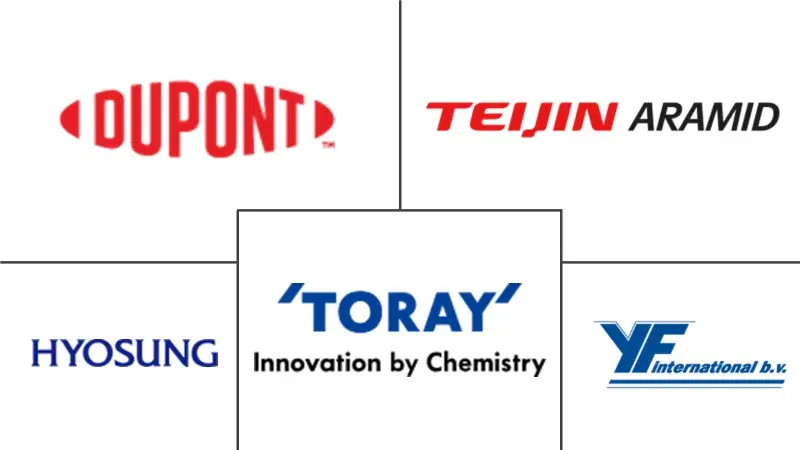
*Disclaimer: Major Players sorted in no particular order |
Middle East and Africa Aramid Fiber Market Analysis
The Middle East And Africa Aramid Fiber Market size is estimated at USD 61.23 million in 2025, and is expected to reach USD 70.99 million by 2030, at a CAGR of greater than 3% during the forecast period (2025-2030).
The COVID-19 pandemic had negatively affected the market in 2020 owing to several restrictions imposed by the governments of Saudi Arabia and South Africa. However, the aramid fiber market recovered well since the restrictions were lifted. In the recent years, the market registered a significant growth rate due to rising demand from the automotive, electronics end-user industries.
- The increase in the usage of aramid fibers as a potential substitute for steel materials and the increase in demand for lightweight materials in the automotive industry are expected to drive the market.
- The availability of better alternatives for aramid fibers is hindering market growth.
- The advancements in aramid materials manufacturing technology are expected to create opportunities for the market during the forecast period.
- The Saudi Arabia is expected to dominate the market due to the rising demand for aramid fibers from automotive, aerospace and defense, electrical, and electronics end-user industries. It is also expected to register the highest CAGR during the forecast period.
Middle East and Africa Aramid Fiber Market Trends
Aerospace and Defence Sector Dominated the Market
- Aramids are used for components and structural applications in all aircraft and spacecraft, ranging from hot air balloons and gliders to fighter planes, passenger airliners, and space shuttles. The aramid fibers are generally used in wing assemblies, helicopter rotor blades, seat propellers, and enclosures for instruments and internal parts.
- Every year, the aerospace industry uses a higher proportion of aramid fibers in constructing each new generation of aircraft due to the provision of an all-weather operation of commercial aircraft and enhanced vision systems. Moreover, characteristics such as temperature stability and durability will further fuel the growth of the aerospace composites market over the coming years.
- In the Middle East and Africa region, governments are always looking for new opportunities to scale the production of airplanes. This has led private manufacturers to plan their expansion for manufacturing facilities in the Middle East region. Thus several companies have announced the establishment of new aircraft manufacturing facilities in the region.
- For instance, in February 2023, Markab Capital, a Dubai-based investment firm, signed an agreement with Super Jet International, an Italian firm, to assemble, install, and produce civil aircraft in the UAE. The plan is to invest nearly USD 180 million, and the facility can manufacture 10 to 15 civil aircraft annually in the production phase.
- Similarly, air passenger traffic is increasing in Saudi Arabia. According to the World Bank Group, the air passenger traffic in the country registered at 31.8 million in 2022, compared to 29.4 million in 2021, at a growth rate of 8%. Thus the growth in air passenger traffic is excepted to drive the market for airplanes in the country, thereby driving the current studied market.
- Thus, the aerospace and defense industry growth is estimated to drive the region's aramid fibers market.
Saudi Arabia to Dominate the Market
- Saudi Arabia is one of the significant markets for Aramid Fibers in the region. Aramid fibers are used in various end-user industries such as aerospace and defense, Automotive, electric and electronics, and sporting goods.
- Saudi Arabia is focusing on establishing itself as the new automotive hub in the Middle East. Although Saudi Arabia is a large importer of vehicles and auto parts, it is now trying to attract original equipment manufacturers (OEMs) to open their production plants in the country to develop its domestic automotive industry.
- Saudi Arabia aims to localize its automotive sector and increase investment opportunities to help the industry develop local manufacturing capacity and align with the Kingdom's Vision 2030 goals to meet its national strategic goals. The kingdom is interested in developing the sector as domestic light vehicle sales are expected to increase by 2.2% over the next decade by 2030.
- The Minister of Industry and Mineral Resources and Chairman of the Saudi Industrial Development Fund (SIDF) announced in May 2022 that Saudi Arabia is targeting to manufacture more than 300,000 cars annually by 2030. Furthurmore, in 2022 the automotive vehicle sales in the country reached 483.24 thousand units compared to 465.10 thousand units in 2021.
- Overall, the growth of industries such as automotive and electronics will likely drive the market for aramid fibers in the country during the forecast period.
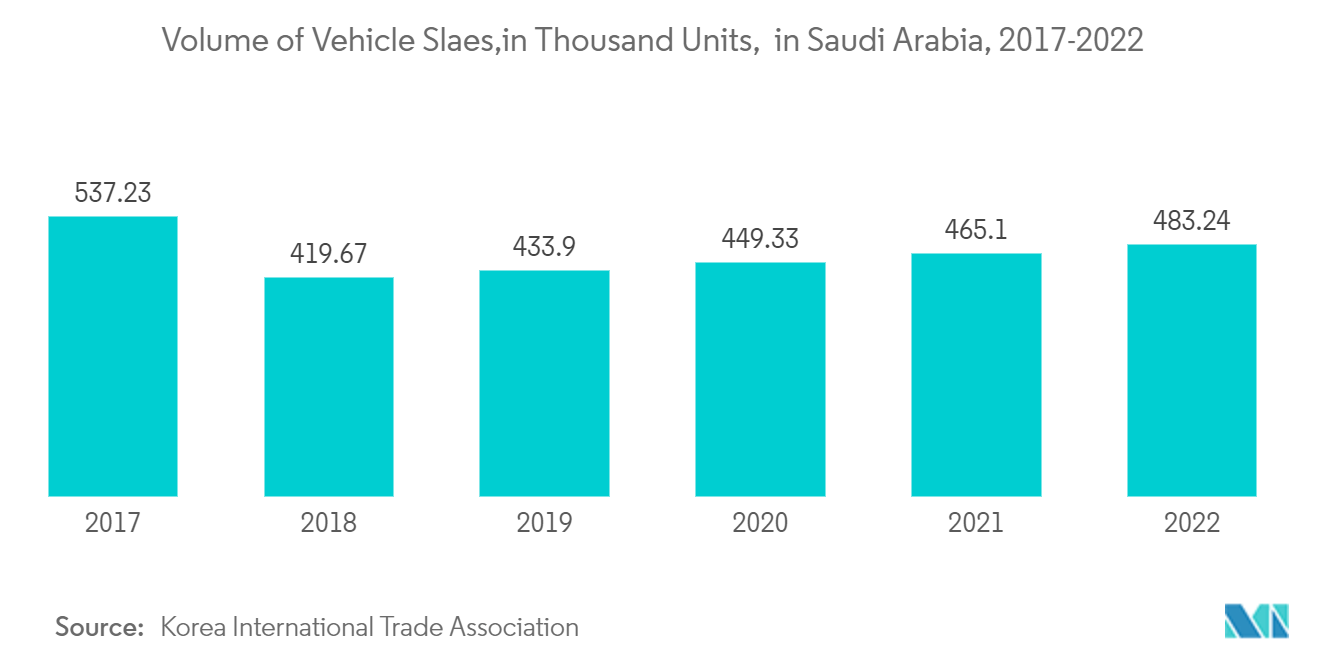
Middle East and Africa Aramid Fiber Industry Overview
The Middle East and Africa aramid fiber market is highly consolidated.Some of the key players in the market (not in any particular order) include Dupont, HYOSUNG, Teijin Aramid, TORAY INDUSTRIES, INC, and YF International bv.
Middle East and Africa Aramid Fiber Market Leaders
-
Dupont
-
HYOSUNG
-
Teijin Aramid
-
TORAY INDUSTRIES, INC.
-
YF International bv
- *Disclaimer: Major Players sorted in no particular order
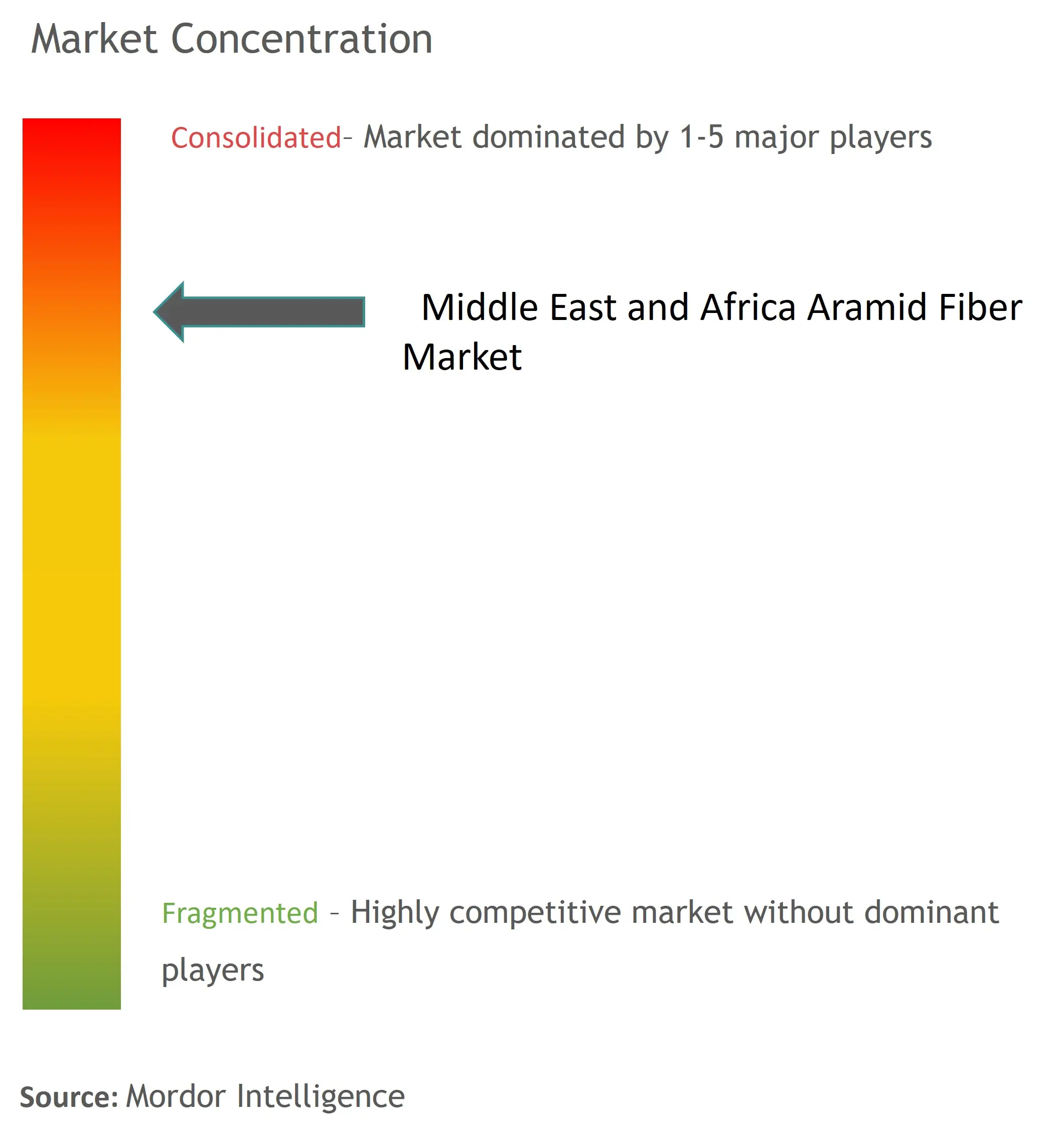
Middle East and Africa Aramid Fiber Market News
- The recent developments pertaining to the major players in the market are being covered in the complete study.
Middle East and Africa Aramid Fiber Industry Segmentation
Aramid fiber is an artificial, high-performance organic fiber manufactured from aromatic polyamides. The critical characteristics of aramid fiber include high strength, good resistance to heat, abrasion, and organic solvents, non-conductivity, and low flammability. It is mainly used for composites, ballistics, optical fiber cables, protective clothing against heat and chemicals, and others.
The Middle East and Africa aramid fiber market is segmented by product type, end-user industry, and geography. By product type, the market is segmented into para-aramid and meta-aramid. By end-user industry, the market is segmented into aerospace and defense, automotive, electrical and electronics, sporting goods, and other end-user industries (oil & gas, telecommunications, etc.).The report also covers the market size and forecasts for the Middle East and Africa Aramid Fiber market for 2 major countries.
For each segment, the market sizing and forecasts are provided in terms of value (USD).
| Product Type | Para-aramid | ||
| Meta-aramid | |||
| End-user Industry | Aerospace and Defense | ||
| Automotive | |||
| Electrical and Electronics | |||
| Sporting Goods | |||
| Other End-user Industries (Oil & Gas, Telecommunication, etc.) | |||
| By Geography | Middle East and Africa | Saudi Arabia | |
| South Africa | |||
| Nigeria | |||
| Qatar | |||
| Egypt | |||
| UAE | |||
| Rest of Middle East and Africa | |||
Middle East and Africa Aramid Fiber Market Research FAQs
How big is the Middle East And Africa Aramid Fiber Market?
The Middle East And Africa Aramid Fiber Market size is expected to reach USD 61.23 million in 2025 and grow at a CAGR of greater than 3% to reach USD 70.99 million by 2030.
What is the current Middle East And Africa Aramid Fiber Market size?
In 2025, the Middle East And Africa Aramid Fiber Market size is expected to reach USD 61.23 million.
Who are the key players in Middle East And Africa Aramid Fiber Market?
Dupont, HYOSUNG, Teijin Aramid, TORAY INDUSTRIES, INC. and YF International bv are the major companies operating in the Middle East And Africa Aramid Fiber Market.
What years does this Middle East And Africa Aramid Fiber Market cover, and what was the market size in 2024?
In 2024, the Middle East And Africa Aramid Fiber Market size was estimated at USD 59.39 million. The report covers the Middle East And Africa Aramid Fiber Market historical market size for years: 2019, 2020, 2021, 2022, 2023 and 2024. The report also forecasts the Middle East And Africa Aramid Fiber Market size for years: 2025, 2026, 2027, 2028, 2029 and 2030.
Our Best Selling Reports
MEA Aramid Fiber Industry Report
Statistics for the 2025 Middle East And Africa Aramid Fiber market share, size and revenue growth rate, created by Mordor Intelligence™ Industry Reports. Middle East And Africa Aramid Fiber analysis includes a market forecast outlook for 2025 to 2030 and historical overview. Get a sample of this industry analysis as a free report PDF download.



